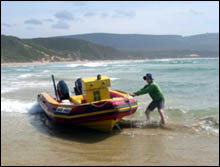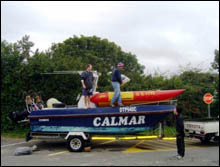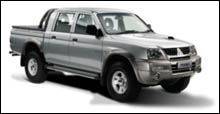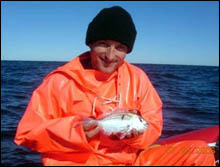SAEON ELWANDLE joins forces with SAIAB, SANParks and Rhodes
|
- Dr Angus Paterson, Manager: SAEON Elwandle Node
With Dr Albrecht Götz joining the SAEON team as post-doctoral fellow, SAEON has become involved in two ongoing monitoring projects in collaboration with the South African Institute for Aquatic Biodiversity (SAIAB) and South African National Parks (SANParks). These are on the inshore marine resources at Woody Cape Nature Reserve and Tsitsikamma National Park. Data sets spanning more than 15 years are actively being built on, and valuable insights into the temporal variability of marine resources have been gained.
In the offshore environment the node is also involved in two projects - one in Algoa Bay, Port Elizabeth and the other in the offshore environment at Tsitsikamma. In Algoa Bay, information has been collected around the Bird Island and St Croix Island group since the beginning of 2006 as part of establishing a baseline and long-term monitoring plan for the Greater Addo Marine Park. The programme, which was commissioned by SANParks and is funded primarily by the World Bank, is led by the Department of Ichthyology and Fisheries Science and EnviroFish Africa and should run for four years.
Through Dr Götz, the SAEON Elwandle Node has played a strong role in the scientific design and actual data collection within the programme. Greater collaboration by SAEON in the programme is expected in 2007, with SAEON undertaking some comparative work on areas outside of the park boundaries and also by providing some additional infrastructure and resources to the programme.
The Tsitsikamma National Marine Park has a long history of marine research activities and SAEON aims to add a number of different components to this research. An array of permanent automated systems, monitoring climate and oceanographic conditions, is already in place and maintained by Marine and Coastal Management. Through monitoring additional biotic and abiotic parameters within the Park, SAEON will be able to examine long-term trends without anthropogenic impacts complicating causal relationships.
Equipment purchase and sharing
Due to the high costs involved in the purchase and maintenance of marine equipment, inter-institutional collaboration is the approach of choice and SAEON is in the process of reaching an agreement with the Department of Ichthyology and Fisheries Science (DIFS) of Rhodes University to share management and usage of their research vessels.
These are "Banga", a 5.5-metre Gemini semi-rigid rubber duck and "Calmar", a 7-metre Butt-Cat ski-boat. Whereas Banga is suitable to launch in most surf conditions along the South African coast, Calmar provides greater comfort, working and loading space. The present fleet is an ideal combination of boats and will allow for all planned marine field operations to be conducted by the Elwandle Node.
To increase the efficiency and safety of marine operations, the Elwandle Node is investing in new marine electronics for these boats. Both vessels will be fitted with a set of state-of-the-art echo-sounder transducers that are connected to a combined sonar-GPS unit (Lowrance LCX-111C HD). This unit can store up to 17 hours of topographic mapping data on its 20GB internal hard drive. GIS/ArcView can interpolate these data into continuous seafloor maps which will be used to assess the suitability of inshore marine environments for long-term monitoring.
The Node has also purchased a new 4x4 vehicle that will enable SAEON staff to tow and launch the vessels. After on-road comparisons of the towing capacity of a variety of vehicles, the choice fell on the Mitsubishi Colt Rodeo 4x4 2.8 litre Turbo-Diesel which had the best combination of engine torque and fuel economy for the required operations.
SAEON staffing
SAEON is very happy to have secured the services of Dr Albrecht Götz as a post- doctoral fellow to lead the Node's marine park monitoring.
Dr Götz gained extensive experience in North Sea ecology during his time studying at a German University, in the Caribbean (one year marine field research in Trinidad for his MSc), and locally, where he has spent four years studying the marine ecosystem in the Goukamma Marine Protected Area.
He has published scientific papers and presented at local and international Marine Science Symposia. With completion of his PhD in South Africa, he has produced ground-breaking research in that he was the first to unequivocally demonstrate the broad ecological impacts of linefishing on the marine offshore environment.
Since completion of his PhD he has being involved in a number of long-term monitoring programmes at Woody Cape, Tsitsikamma and Algoa Bay in collaboration with the Department of Ichthyology and Fisheries Science, EnviroFish Africa, SANParks and SAIAB.















